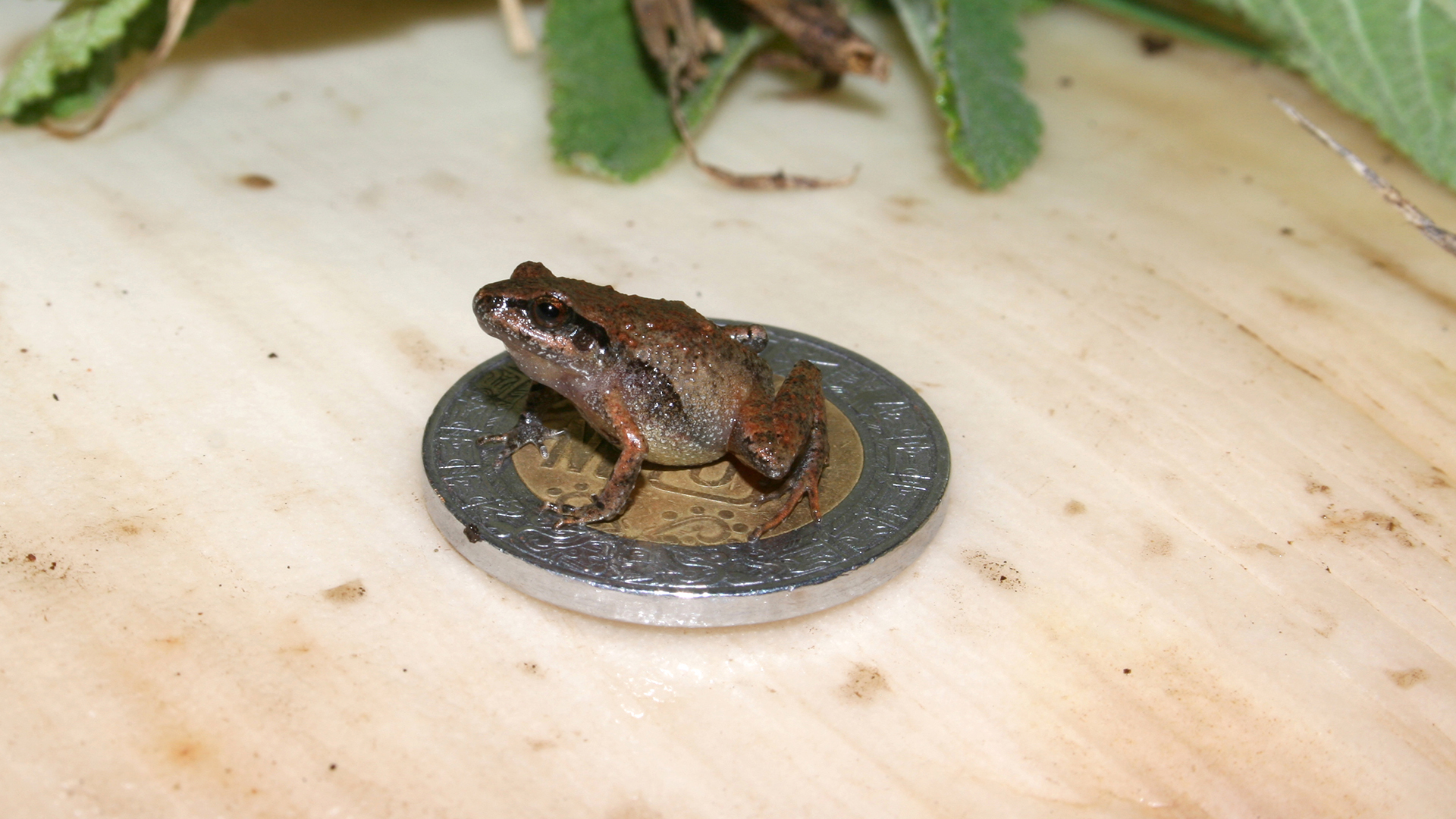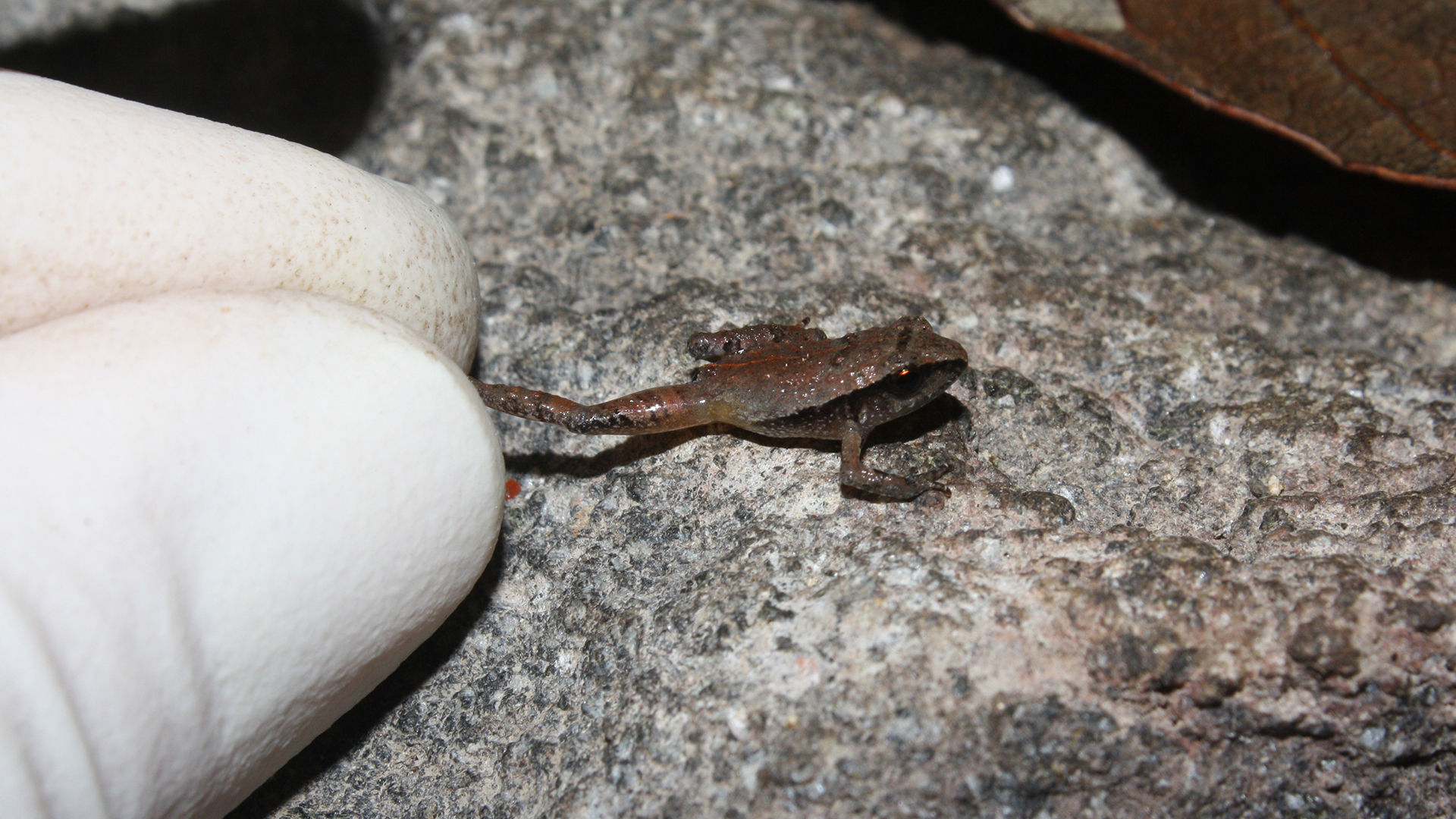Newfound species of wee frogs found in Mexico can fit on your fingertip
Little is known about the habits and biology of these lilliputian amphibians.

Six newly-described species of miniature frogs from Mexico and Guatemala are so tiny that each can fit comfortably on a human thumbnail. Two of the species are smaller than 0.7 inches (18 millimeters) long, and the tiniest of them — Craugastor candelariensis — is Mexico's smallest frog, measuring no more than 0.5 inches (13 mm) long.
The wee frogs live in moist leaf litter on forest floors and are known as direct-developing frogs, which means that they don't undergo a tadpole stage as part of their life cycle, the researchers who described the species wrote in a new study. Rather, the frogs hatch from eggs as miniature versions of their adult forms.
Hatchlings are thought to measure less than than 0.4 inches (10 mm) long, but scientists aren't certain about that because no one has ever seen these frogs hatch, said lead study author Tom Jameson, a researcher in the Department of Zoology at the University of Cambridge in the United Kingdom, and a doctoral candidate in the Cambridge Climate, Life and Earth (C-CLEAR) program.
"We know very little about their reproduction, life history, and behaviour," Jameson told Live Science in an email.
Related: Cannibal toads eat so many of their young, they're speeding up evolution
Other scientists had collected the frogs years ago and placed them in museum collections, cataloging the minuscule amphibians as undefined species in the Craugastor genus or as possibly belonging to the miniature frog species C. pygmaeus or C. hobartsmithii, the study authors reported April 4 in the journal Herpetological Monographs.
However, the diminutive frogs all looked so similar that scientists couldn't be sure exactly where the frogs fit on the Craugastor family tree.
Sign up for the Live Science daily newsletter now
Get the world’s most fascinating discoveries delivered straight to your inbox.
"We revisited this classification because one of my co-authors, Jeff Streicher [a senior curator of amphibians and reptiles at the Natural History Museum in London], did some genetic analysis back in 2012 and found a pattern that suggested multiple undescribed species," Jameson explained.

The researchers then followed up on Streicher's findings by conducting DNA analysis of the Craugastor specimens in question, and using computed X-ray tomography (CT) scans to create 3D digital models that highlighted differences in the shapes of frog bones and body parts. When their analysis was done, the scientists grouped the specimens into six new species: C. bitonium, C. candelariensis, C. cueyatl, C. polaclavus, C. portilloensis and C. rubinus.
"We found that each species was genetically distinct," Jameson said. "We also found differences in skull shape, level of ossification of the skeleton, and in external features like the number of tubercles [hardened bumps] on the hands and feet."
Because the frogs are so small, they're on the menu for just about every predator in their woodland ecosystem, including birds, lizards, small mammals, and even large insects and other frogs, Jameson said. But the frogs face much greater risks from human activities, he added.
"The real threat to these frogs comes from habitat loss, climate change (further modifying habitats), and disease," such as the highly infectious fungal disease chytridiomycosis, or chytrid disease, Jameson wrote in the email. Chytrid disease is caused by the fungus Batrachochytrium dendrobatidis, which infects amphibians through their skin and is easily spread to new habitats by humans, according to the Cornell Wildlife Health Lab at Cornell University in Ithaca, New York.
Despite their small size, these frogs could represent the tip of a very big iceberg of unknown amphibian biodiversity in the region, the study authors reported.
"We suspect that additional species await discovery, particularly in western Mexico and east of the Isthmus of Tehuantepec where our sampling efforts were limited," the authors wrote.
Originally published on Live Science.

Mindy Weisberger is an editor at Scholastic and a former Live Science channel editor and senior writer. She has reported on general science, covering climate change, paleontology, biology and space. Mindy studied film at Columbia University; prior to Live Science she produced, wrote and directed media for the American Museum of Natural History in New York City. Her videos about dinosaurs, astrophysics, biodiversity and evolution appear in museums and science centers worldwide, earning awards such as the CINE Golden Eagle and the Communicator Award of Excellence. Her writing has also appeared in Scientific American, The Washington Post and How It Works Magazine. Her book "Rise of the Zombie Bugs: The Surprising Science of Parasitic Mind Control" will be published in spring 2025 by Johns Hopkins University Press.










